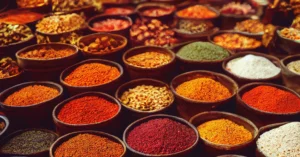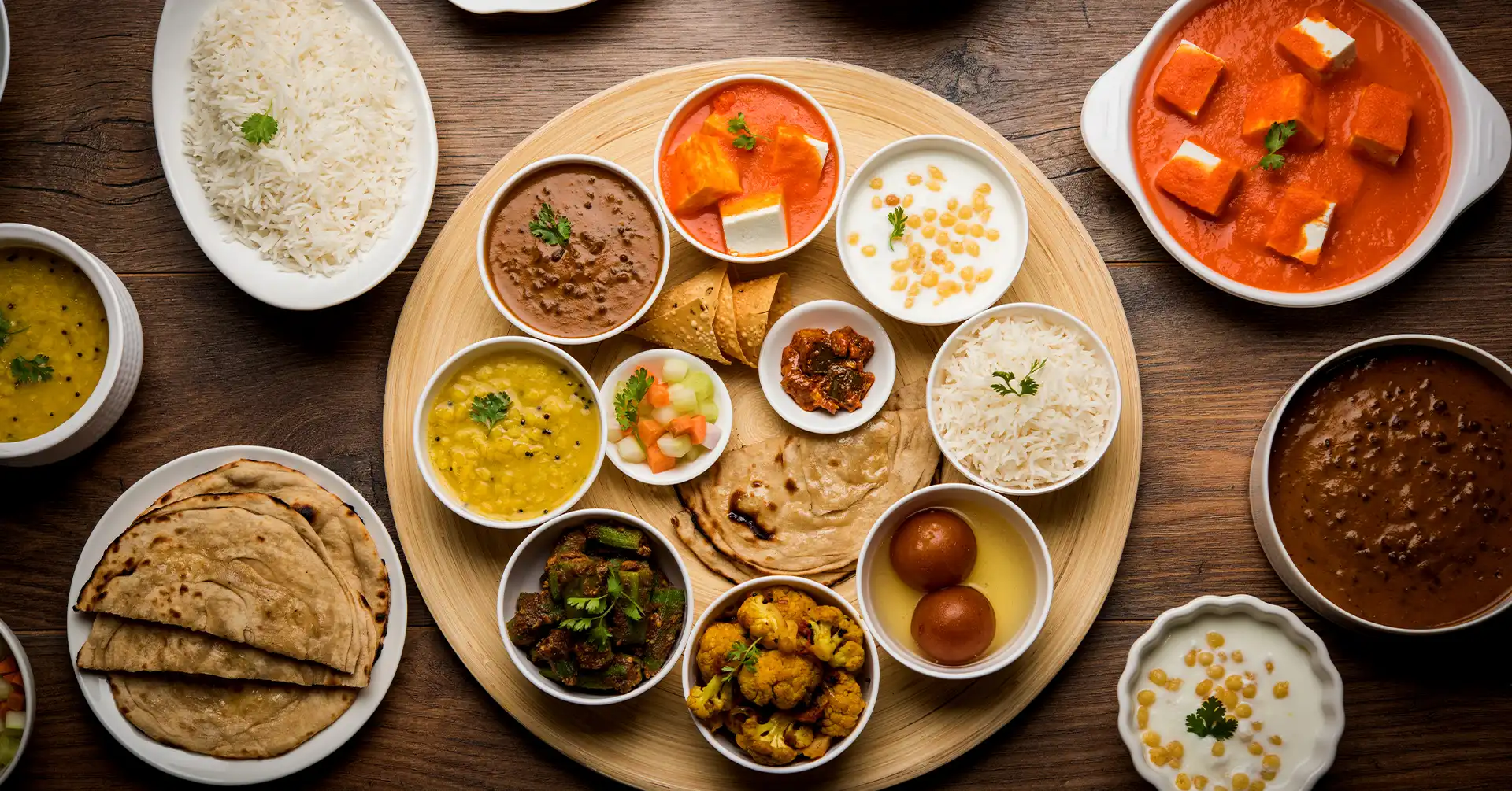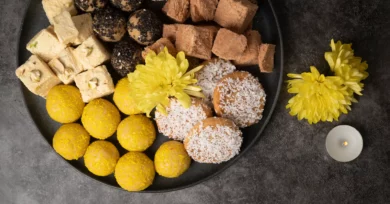The roots of Indian cuisine, embedded in Sanskrit with terms like “bhojana” and “khana” in Hindi, stretch beyond mere sustenance. They reflect a historical journey from a 1960s food economy teetering on famine to today’s India, where food is not just abundant but a celebrated aspect of daily life. We witness a culinary landscape transformed by a growing economy, liberalization, and a burgeoning middle-class Indian Culture through Food.
Food and Identity: Beyond the Plate
Food in India goes beyond the act of eating; it becomes a marker of identity intricately woven into caste, class, family, religiosity, and more. The diversity of Indian cuisine, comprising myriad local and regional flavors, reflects a celebration of distinctiveness. As globalization nudges at the boundaries, we examine how food resists and adapts to external influences, becoming a pivotal element in the ongoing dialogue about nationalism and Indian identities.
Overview of Indian Culinary Landscape: From Spices to Street Food
In the vast expanse of Indian gastronomy, there’s no monolithic “Indian” food but a kaleidoscope of local, regional, and caste-based ingredients and cooking methods. From cooking shows featuring celebrity chefs to the popularity of indigenous street food, the culinary panorama is both traditional and dynamic. We explore how the culinary imagination in India conceptualizes food, reflecting its complex historical and contemporary relations with foreign cultures.
Gastronomic Evolution: Unveiling the Culinary Journey of Indian Culture through Food
Indian cuisine, a rich tapestry of flavors and traditions, has undergone a fascinating gastronomic evolution throughout history. This evolution can be dissected into key periods that shaped the diverse and vibrant culinary landscape we see today.
Influence of Central Asian Invaders: Infusion of Exotic Tastes
Centuries ago, Central Asian invaders left an indelible mark on Indian food culture. The arrival of dynasties known as the Sultanates in the twelfth century heralded a significant culinary shift. These invaders, bringing dried fruits, pilafs, leavened bread, and novel cooking techniques, laid the foundation for what we now recognize as Mughlai haute courtly cuisine.
The Mughal Dynasty’s Culinary Legacy: Fusion of Ingredients and Techniques
The Mughals, from the sixteenth to the nineteenth centuries, further enriched Indian cuisine. They introduced exotic ingredients like spices and vegetables, creating a distinctive Mughlai culinary identity. Cooking methods such as baking bread in tandoors and marinating meats with yogurt-based concoctions became integral. The Mughals not only influenced princely kitchens but also left an enduring impact on the culinary landscape of ordinary households.
Culinary Impact of British Rule: A Fusion of East and West
The advent of the British, initially as the East India Company and later as the British Raj from 1857 to 1947, brought yet another layer of culinary influence. Seeking spices, they inadvertently initiated culinary exchanges that transformed Indian food. Indian cooks, trained by the English, blended traditional flavors with English culinary elements. The result was a fusion of bread, mulligatawny soup, roasts, and puddings, creating a unique Anglo-Indian cuisine that permeated Indian army officer messes and British-Indian club menus.
Diversity in Indian Cuisine: Exploring Indian Culture Through Food
Regional and Local Cuisines
Indian culture through food showcases a rich tapestry of regional and local cuisines, each with distinctive flavors and culinary traditions. The country’s vastness is reflected in the diverse ingredients, cooking methods, and tastes that vary from region to region. From the robust spices of the North to the coconut-infused delicacies of the South, regional cuisines provide a glimpse into India’s geographical and cultural diversity.
In bustling metropolitan areas and serene rural landscapes, the local culinary scene is a testament to the unique ingredients and cooking styles indigenous to specific locales. This culinary diversity caters to local preferences and contributes to the broader narrative of Indian culture expressed through food.
Caste and Religion-based Dietary Practices
Indian cuisine is intricately woven into the fabric of societal structures, with food serving as an identity marker for various aspects such as caste, class, and religion. Dietary practices are deeply rooted in cultural and religious beliefs, influencing what is acceptable or forbidden. For example, upper-caste Hindus often follow vegetarian diets, avoiding certain ingredients like onions and garlic, while other communities may embrace meat consumption with specific restrictions.
These culinary distinctions based on caste and religion shape individual dietary choices and contribute to the broader cultural mosaic that defines Indian gastronomy. Exploring Indian culture through food requires understanding the historical and social factors that have molded these dietary practices over generations.
Indian Meal Structure and Symbolism
Components of an Indian Meal
An Indian meal is a harmonious blend of diverse elements beyond mere sustenance. The typical meal structure includes a main starch like rice or wheat, complemented by vegetable or meat curries, lentil soups, and various condiments. The concept of a ‘thali,’ a platter containing various dishes, epitomizes the comprehensive nature of Indian meals. The diversity of flavors and textures within a single meal mirrors the cultural diversity inherent in Indian society.
Symbolism of Rice
Rice, a staple in many Indian households, transcends its role as a mere food item to symbolize both hunger and fulfillment. Historically associated with prosperity, rice holds cultural significance in various rites, including marriage ceremonies. The careful preparation and consumption of rice carry symbolic weight, reflecting a cultural connection to fertility, wealth, and familial traditions.
Culinary Symbolism in Rituals and Festivals
Indian festivals and rituals often center around food, emphasizing the symbolic importance of culinary elements. Certain dishes and ingredients become integral to religious ceremonies, embodying auspiciousness and tradition. The culinary symbolism extends to the timing and order of dishes, contributing to a holistic experience beyond taste, touching upon spiritual and cultural dimensions.
Gastronomic Calendars, Rituals, and Seasonality

Influence of Climate and Natural Resources
Indian Culture, through Food, is intricately linked to the country’s geographical diversity. The varying climates and abundant natural resources shape how Indians approach their meals. The region’s climate influences ingredients’ availability, determining what can be grown or sourced locally.
Indian Culture through Food reflects the agricultural practices that adapt to diverse climates, allowing people to enjoy fresh and in-season produce. The culinary landscape transforms with the changing seasons, creating a dynamic and ever-evolving array of dishes.
Seasonal Eating Practices
The concept of Indian Culture through Food is exemplified in seasonal eating. Locals embrace consuming foods at their peak, both in flavor and nutritional value. Seasonal fruits, vegetables, and herbs become central to meals, showcasing the connection between the natural cycle and the dining table.
Indian Culture, through Food, encourages an appreciation for the rhythm of nature, emphasizing the importance of consuming foods when they are naturally abundant. This enhances the overall dining experience and aligns with the principles of sustainable and locally sourced eating.
Culinary Significance in Religious Festivals
Religious festivals play a pivotal role in Indian Culture through Food. Each festival comes with its own set of culinary traditions and rituals. Certain dishes are prepared exclusively during specific celebrations, and sharing these meals becomes a sacred practice.
The essence of Indian Culture through Food is profoundly felt during religious festivities, where the preparation and consumption of specific dishes symbolize cultural identity and spiritual significance. These culinary traditions are passed down through generations, reinforcing the cultural fabric that binds the diverse communities across India.
The Globalization of Indian Food
Impact of Multinational Fast Food Companies
Multinational fast-food giants have significantly influenced the globalization of Indian Culture through Food. These companies, drawn to India’s burgeoning market, have adapted their offerings to suit local tastes. The infiltration of international fast food has not only added a new dimension to Indian cuisine but has also transformed the dietary habits of the urban middle class.
Indian Culture through Food experiences a fusion of traditional flavors with global influences as multinational fast food chains become ubiquitous. The impact is visible in urban centers and how younger generations perceive and engage with their culinary heritage.
Local Food Purveyors and Packaged Food Boom
Simultaneously, local food purveyors in India have responded to changing lifestyles and preferences. The concept of Indian Culture through Food shifts as traditional recipes are modified for mass production and distribution. Packaged foods from Indian companies like MTR, SWAD, Haldirams, and Pataks have gone global, subtly revolutionizing eating habits.
The packaged food boom has reengineered perceptions of what is considered traditional in Indian Culture through Food. Industrialized, processed foods are becoming more prevalent, challenging historical notions of the importance placed on rural, natural, and freshly prepared meals.
Branding of Indian Cuisine Abroad
Indian Culture through Food is now a global phenomenon, largely influenced by the branding of Indian cuisine outside the country. Curry houses in the United Kingdom have played a crucial role in shaping the perception of Indian food worldwide. The term “curry” itself, representing a category of dishes, has become synonymous with Indian cuisine abroad.
Indian culture through food is being showcased internationally, with Indian restaurants offering a curated selection of dishes that cater to diverse tastes. The globalization of Indian cuisine is not only a culinary exchange but also a representation of India’s cultural influence on a global scale.
Future Trends and Challenges

Changing Culinary Landscape in Urban India
The evolving landscape of Indian culture through food in urban India reflects dynamic shifts in dietary preferences and lifestyle choices. As the influence of globalization continues to grow, there is an increased demand for diverse and convenient food options.
Indian culture, through food, faces the challenge of balancing traditional culinary practices with a fast-paced urban lifestyle. The emergence of quick-service restaurants and the popularity of pre-packaged meals indicate a departure from traditional cooking methods.
Impact of Globalization on Traditional Eating Habits
The ongoing globalization of Indian Culture through Food raises questions about preserving traditional culinary practices. While international influences bring exciting culinary innovations, there is a need to safeguard and promote the authenticity of regional and local cuisines.
Balancing the integration of global flavors with preserving indigenous culinary heritage is a challenge that the future of Indian Culture through Food must navigate. Striking this balance will ensure a rich and diverse culinary tapestry that honors the country’s cultural legacy.
Areas for Future Research
In the realm of Indian culture through food, there is a vast landscape for exploration and research. Scholars and enthusiasts can delve into topics such as the impact of globalization on specific regional cuisines, the role of social media in shaping culinary trends, and the evolving perceptions of health and sustainability in Indian dietary practices.
Final Words
Indian Culture through Food is a vibrant tapestry woven with diverse flavors, culinary practices, and rituals. From the profound influence of climate and natural resources to the globalization-driven transformations, the article has illuminated the intricate connections between food, identity, and cultural dynamics. As India navigates the evolving culinary landscape, balancing tradition with innovation, the future promises continued exploration and preservation of the rich culinary heritage that defines Indian Culture through Food.
Read More:
Similar Cultures of the World- Unity in Cultural Diversity






